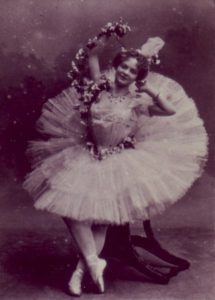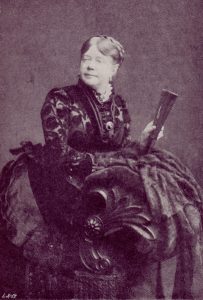Ballet in Britain’s Music Halls, 1850-1910
Think ballet, think opera house? Think again! Ballet has long had a proud heritage on the popular stage too, where local talent and international stars glammed it up and promoted ballet to audiences across the globe.
In the mid nineteenth century, the audience for ballet expanded rapidly as dancing became an essential ingredient of popular entertainment and vaudeville. This was the age of the humble, downtrodden ‘ballet girl’. But it was also the time of feisty, creative women like Katti Lanner and Albina de Rhona, who choreographed and directed ballets for an enormous public of ordinary men and women.
In Britain, the introduction of the Theatre Regulation Act (1843) spurred the growth of dozens of new theatrical establishments, bringing to an end the monopoly of the patent theatres, Drury Lane and Covent Garden. Among the new venues that offered ballet in London were the Canterbury Music Hall in Lambeth, the Oxford near Tottenham Court Road, South London Palace near the Elephant and Castle, and the Adelphi Theatre.1 However, by far the best known venues for ballet were the Alhambra Theatre and the Empire Theatre in Leicester Square. In 1864, the Alhambra made ballet the cornerstone of its offerings. The venue’s proprietor, Frederick Strange, “engaged a big band, a big chorus, and a big ballet,” and covered the vast area of the pit “with an acre of valuable carpet.”2 The carpet gave the theatre an air of distinction. The ballet gave audiences the perfect light entertainment to enjoy over drinks or watch for an evening.

America
Costume design by Lucien Besche created for Our Army and Navy, a ‘grand spectacle’ staged at the Alhambra Theatre in 1889.
Some of these venues – including the Alhambra – specialized in vast ballet ‘spectaculars’ that celebrated national pride and popular culture, and employed vast numbers of girls and young women. At other times, performances took the form of divertissements, pantomimes or narrative ballets that drew inspiration from existing works such as La Sylphide, Paquita, Flick und Flock and Swan Lake. Increasingly, a younger generation of foreign-trained stars opted to take up work in these venues, often between more prestigious engagements in Europe’s opera houses. At the Alhambra and Empire theatres, they included the beloved Danish dancer Adeline Genee, as well as Emma Palladino, Emma Bessone and Rita Sangalli, who brought with them the dazzling technique and showmanship of their Italian schooling. Another celebrated Italian, Pierina Legnani, made her London debut at the Alhambra in 1888. Today, she is famous as the ballerina who created the role of Odette/Odile in Marius Petipa’s production of Swan Lake (1895).
Filling the scene behind these luminaries from abroad was an enormous corps of young women trained locally in London. Frequently belittled for their poor technique and lowly aspirations, many came from London’s working class families. Others were members of theatrical families and enjoyed the relative advantages of familial networks and access to respected local teachers. By the beginning of the twentieth century, a growing number of local dancers were finding success on music hall stages, among them Britain’s first prima ballerina Phyllis Bedells and a young Ninette de Valois.3
In 1909, a new force began to cast its influence over the music halls. In Paris, Diaghilev’s Ballets Russes revealed for the first time the extraordinary artistry of Russia’s ballet dancers. London’s music-hall managers took immediate steps to engage these artists either individually or in small groups, bringing dancers such as Anna Pavlova and Mikhail Mordkin, Tamara Karsavina and Olga Preobrazhenskaya to London ahead of appearances by the Ballets Russes in 1911. However, the creativity, cultural sophistication and charismatic performances of the Ballets Russes rapidly diminished the appeal of the music halls’ massed displays of saucy ballet girls. Although dance continued to be a part of offerings at both the Alhambra and Empire, the venues gradually shifted their focus from variety entertainments to revue. 4

Adeline Genee
All five founding members of today’s Royal Academy of Dance, including Genee, had an association with music halls.
Although often neglected by conventional histories of ballet, the world of the music hall ballet is gradually gaining recognition as a significant and vibrant part of ballet’s past, one that defined ‘ballet’ for generations of theatre goers.5 As eminent ballet historian Ivor Guest notes, “The era of the music-hall ballet was not devoid of achievements that would endure to the benefit of later generations.”6 Colourful, cheerful and often racy, this was ballet at its most extrovert: “Plie, jete, chaise and TA-RA-RA BOOM-DEE-AY!”
LISTEN to the BBC radio documentary ‘Ballet Goes to the Music Hall‘, hosted by former Royal Ballet principal dancer, Deborah Bull. In this informative 45-minute program, she talks with dance historian Jane Pritchard about the type of dancing presented at the Alhambra and Empire Theatres. Listeners also have the rare opportunity to hear music that was composed for ballets at these venues, specially performed and recorded by the BBC Concert Orchestra.
- Ivor Guest, Ballet in Leicester Square (London: Dance Books, 1992) 6 ↩
- Sir Walter Besant, London in the Nineteenth Century (London, 1909) 195. ↩
- ‘Dance in Popular Theatre‘, Victoria and Albert Museum. ↩
- Guest, Ballet in Leicester Square, 80-83. ↩
- Ballet Goes to the Music Hall, hosted by Deborah Bull. BBC Radio 3, 2011. LISTEN ↩
- Guest, Ballet in Leicester Square, 9. ↩


Leave a Reply